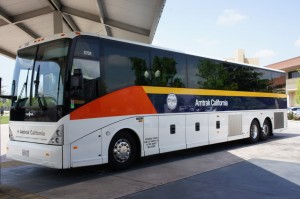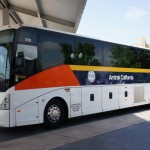With the news that the California High Speed Rail Authority is on the verge of ditching the Southern California connection in favor of the cheaper Silicon Valley route, the country’s second-largest city is facing the prospect of missing out on high speed rail for decades to come.
The decision makes sense, given the financial hole that decision-makers have created for the system.
But Southern California doesn’t have to be left out completely. For potentially a fraction of the cost of expensive tunneling and mountain-hopping from Bakersfield to Burbank, the existing Amtrak line could be upgraded and connected to the Valley.
As I wrote about back in 2014, the current Amtrak connection in the interior of the state doesn’t even go all the way through to LA. Instead, it requires a bus transfer in Bakersfield over the Tehachapi mountains at the southern end of the Central Valley. Meanwhile, freight trains have a congested route from Bakersfield into Mojave that could be double-tracked in more places and opened to passenger rail service from Los Angeles.
So why not improve this route and boost passenger rail service? It could be a solid investment with immediate returns, and it would create a passenger base that could eventually be converted to high speed rail, whenever the state gets more money to finish the job.
And at this rate, that could be decades from now.
In the wake of the Philadelphia Amtrak crash, my Zocalo co-panelist Tom Zoellner pens a Washington Post op-ed bemoaning the sorry state of Amtrak, due to federal policy:
So don’t blame Amtrak for the mess. Blame history and the law. If Americans really want anything more from their passenger trains besides a future of lumbering banality — besmirched by a few dozen derailments and a handful of passengers killed each year — the 1970 law must be amended to guarantee a healthy level of federal support, clearly prioritize passenger trains over freights, take posturing by Congress out of the equation, double-down on advertising and capturing new customers and lay down dedicated tracks outside the Northeast Corridor. The current Passenger Rail Reform and Investment Act of 2015 doles out what amounts to more starvation rations: a paltry $7 billion over the next four years, which means nothing is going to change. Amtrak needs to stop becoming a symbol of American incompetence and start leading the way in an era of fuel shortages and highway congestion.
He compares rail in the United States to rail in Europe:
Americans who vacation in Europe are frequently struck by the professionalism, convenience and reach of the continent’s rail network and ask a very good question: Why can’t we do that here? How can a nation whose industrial power was built by the railroads be left with a starving system that might embarrass former Soviet bloc countries?
The one big difference Tom doesn’t note though is that European cities are much closer together than many U.S. cities, outside of the northeast corridor of course. Given the vast size of this country, passenger rail has a hard time competing with airplanes for many trips. Rail is best suited to cities that are too close to fly but too far away to drive conveniently.
But Tom’s larger point is correct: you get what you pay for. And in the case of Amtrak, regardless of the cause of this accident, prioritizing freight over passengers and starving the train budget means we’re not getting enough.
Caltrans announced the groundbreaking of a $38 million rail project that will add 3.8 additional miles of track to the Los Angeles area, vastly improving Amtrak service between San Diego, Los Angeles and San Luis Obispo.
The “Triple Track Project” is fully-funded from stimulus dollars (remember those?) as part of a larger $163 million, 15-mile main line track expansion between the cities of Commerce and Fullerton in Southern California. The project will lay an additional third track next to the two existing lines.
For all the hype about high speed rail, improvements to our existing Amtrak service like these are much cheaper and faster to build. It’s not an excuse not to do high speed rail necessarily, but these investments will still be necessary, given the limited route, long time horizons, and expense of building high speed rail.
So says Tom Zoellner, my co-panelist at last month’s Zocalo event on public transit in LA and author of the engaging book Train. In Tom’s San Francisco Chronicle op-ed, he notes that Amtrak actually does by law have priority over freight, but that it’s not enforced in practice:
Big carriers like BNSF, Union Pacific and Norfolk Southern are required under a 1973 law to make way for Amtrak trains. Yet the freights often treat Amtrak not like a visiting royal but a drunk party crasher. Dispatchers habitually make passenger trains wait for the “hotshot” trains carrying coal or liquid crude, even though the federal law says clearly: “Amtrak has preference over freight transportation in using a rail line, junction, or crossing.”
A potential Amtrak renaissance is buried in that one sentence — which should carry the force of law because it is the law — but is currently a meaningless blandishment because the Surface Transportation Board has no staff or incentive to crack down on Fortune 500 companies with political clout. Amtrak tried to get confrontational about this in 2012 when it complained about the Canadian National Railway, only to bring on a year and a half of talks that went nowhere. A more recent complaint against Norfolk Southern is also likely to end with murky outcomes and frustration.
He recommends that we tweet our congressional representatives with the hashtag #Amtrak2step. I will follow through. Amtrak is a low-cost alternative to more expensive forms of transportation, including high speed rail. Beefing up that service while we wait decades for better options should be a priority, and it starts with putting freight trains back in line as the law requires.
High speed rail is going to take decades to build in California. Meanwhile, the state has a functioning passenger rail system in Amtrak. Matt Dellinger of The Atlantic’s CityLab takes a ride on the state’s two Amtrak lines, one along the coast and one through the Central Valley. The coast line is largely geared for tourists and the leisure class:
The passengers boarding the Coast Starlight that morning were not preoccupied with “quick” and “cheap.” My lunch companions, Maureen and her tweener son, Kyle, were travelling from their home in Beverly Hills to visit friends in San Jose. They suffered no phobias or disability that would prevent them from flying. They simply find the long trip enjoyable, and peaceful, a chance to see the gorgeous coastline.
Meanwhile, the Central Valley line is much more functional:
If you are in a hurry, the “fast” Amtrak connection between the Bay Area and Los Angeles is not the meandering Coast Starlight, but Amtrak’s San Joaquin line, which goes straight through the flat, open Central Valley. This train is more prosaic. The rolling stock is newer, more modern, more commuter-like. There are fewer amenities—no movie theatre, no observation parlor with swivel seats—but it’s comfortable, there are a lot of tables among the seating, and the WiFi works.
Frustratingly, this more useful line doesn’t even go all the way through to LA, requiring a bus transfer in Bakersfield over the Tehachapi mountains at the southern end of the Central Valley. Meanwhile, Dellinger notes that the planned high speed rail line in this section of the state is odd and that readers are “forgiven if you’re not sure why a high speed train line between two major cities isn’t starting in either major city.”
This story raises the question: why not just improve Amtrak service on the Valley line? Freight trains currently ride over the Tehachapis, so presumably for a relatively small investment, we could create additional track to allow the Valley line a straight shot to LA. It would be cheaper than high speed rail, boost ridership and utility, and reach completion potentially years before the state ever sees high speed rail service. And even when statewide high speed rail service begins in the (gulp) 2030s, we’ll still need a cheaper Amtrak service with more frequent stops.
We can dream about hyperloops all we want, but sometimes the simplest solution is right in front of us.




